
 |
|
|
Anatomy of Armour: Specimens from the 16th Century
An Article by Nathan Robinson 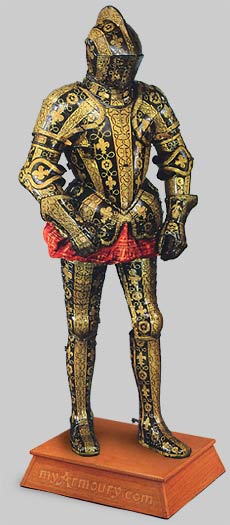 The Armour of George Clifford, Earl of Cumberland
The Armour of George Clifford, Earl of Cumberland(1558-1605; Earl, 1570) Jacob Halder, Greenwich, circa 1590 Metropolitan Museum of Art, New York In 1515 King Henry VIII of England set up a royal armoury, which employed Netherlandish and German craftsmen and was modeled on the workshops of his ally, the Emperor Maximilian I. About ten years later it found a permanent home near the royal residence of Greenwich and soon developed its own particular style. The Greenwich School was characterized by the most careful design, functional but economic arrangement of garnitures, and a love of technical devices and unusual forms. About 1555 Jacob Halder came to Greenwich from Augsburg, an appointment that was probably due to the marriage of the Roman Catholic Queen Mary of England to Philip II of Spain in 1554. The English court was now interested in the Augsburg armour and etching that was preferred by the Spaniards, and Halder seems to have mastered this latter technique in addition to his skill as an armourer. When Queen Elizabeth (1558-1603) came to power, Halder, in spite of her opposition to Roman Catholicism, played an increasingly important role. Between 1576 and 1607 he was master armourer and led the workshop to the peak of its artistic achievements. After Mary, Queen of Scots, was beheaded in 1587, the country was threatened by a campaign of revenge on the part of Philip II of Spain; finally, in 1588, the Armada was sent to England, only to be sunk. During this period Halder was called on to produce a great many simpler field armours as equipment for English courtiers. However, both before and after, he continued to create a number of superb armours for the same circle. Sketches of his own creations and those of his predecessors, Erasmus Kirkener and John Kelte, were included by him in the so-called Greenwich Album, which today is one of the treasures of The Victoria and Albert Museum in London. The armour of the Earl of Cumberland from Appleby Castle must be regarded as Halder's greatest achievement. It is of the highest quality, even though the excessively long and pointed form of the breast may appear strange. This peascod breastplate corresponded to the period's bizarre fashion created by King Henry III of France. The gilded etching against a purplish ground combines different styles in a masterly manner: the alternating bands and emblems—in this case the Virgin Queen's Tudor roses and lilies—had their origin in Italy, whilst the etcher used designs by the Frenchman Jacques I. Androuet Ducerceau ( 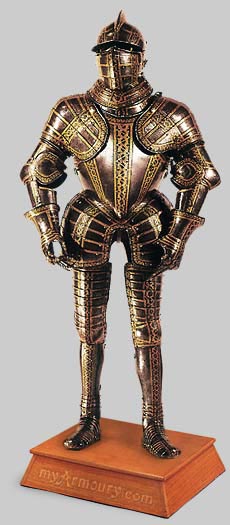 Greenwich Armour of Thomas Sackville
Greenwich Armour of Thomas SackvilleEarl of Dorset (1536-1609) Jacob Halder, circa 1595 The Wallace Collection, London Although there was an Armourer's Company in London as early as the fourteenth century, those Englishmen who could afford it purchased armour of fine quality from the great arms centres of Milan, Augsburg and Nuremberg. In 1511 Henry VIII brought some noted armourers over from Milan and Brussels to set up a workshop in London capable of producing armours rivalling the best Continental products. In 1514 he received a magnificent armour from the Emperor Maximilian I which made a great impression on him and encouraged him to persuade some German or Almain armourers to join his workshops, which were now established at Greenwich. The Royal Armouries soon developed a style of their own in which Italian and German influences, though discernible, are restrained by a characteristic English simplicity and solidity. The armour shown here was intended for the sport of fighting on foot, and covered the body from head to foot. 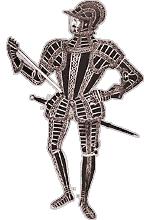 Much of our knowledge of Greenwich armour comes from a book containing drawings of armour in pen and watercolor, each bearing the name of an English gentleman of the reigns of Mary and Elizabeth I. The album is signed by "Jacobe", who has been identified as Jacob Halder, Master Workman of the Greenwich workshop 1576-1605. Many of the armours made to the designs in this album are still in existence and have been identified by their shape and decoration. They include the armour of Sir Christopher Hatton (Windsor Castle), the Earl of Worcester and Sir John Smythe (Tower of London), and the Second Earl of Pembroke and the Earl of Cumberland (Metropolitan Museum, New York). The drawing shown opposite marked "My Lord Bucarte" refers to the armour of one of Elizabeth's favorites, Thomas Sackville, Baron Buckhurst, now in the Wallace Collection.
Much of our knowledge of Greenwich armour comes from a book containing drawings of armour in pen and watercolor, each bearing the name of an English gentleman of the reigns of Mary and Elizabeth I. The album is signed by "Jacobe", who has been identified as Jacob Halder, Master Workman of the Greenwich workshop 1576-1605. Many of the armours made to the designs in this album are still in existence and have been identified by their shape and decoration. They include the armour of Sir Christopher Hatton (Windsor Castle), the Earl of Worcester and Sir John Smythe (Tower of London), and the Second Earl of Pembroke and the Earl of Cumberland (Metropolitan Museum, New York). The drawing shown opposite marked "My Lord Bucarte" refers to the armour of one of Elizabeth's favorites, Thomas Sackville, Baron Buckhurst, now in the Wallace Collection.This field armour is interesting not only for its quality but in that it is made with additional pieces which can be put on for increased protection. These extra parts shown here are a placarte, or reinforcement to the breastplate, and a falling buffe, or face-guard, which can be fitted to close the otherwise open helmet. The decoration is of a zigzag-and-scroll design of gilt areas over a plum-colored browned background. 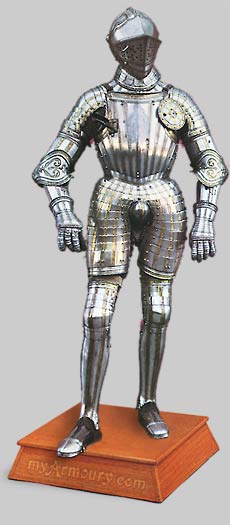
The Field Armour "de fajas espesas" of the Emperor Charles V (1500-58; Emperor, 1519) Desiderius Helmschmid, Augsburg, 1558 Real Armerķa, Madrid The indefatigable Emperor conquered Tunis in the fortunate and victorious campaign of 1555, so putting an end to the excesses of the Muslim pirates. Then, with the peace of Nice concluded in 1558, he achieved a provisional compromise with King Francis I of France. In the same year an uprising called him to the Netherlands where the Protestant princes emerged as the result of the Reformation as new opponents of the Emperor of the Holy Roman Empire. The "Schmalkaldic League" was turning into a menacingly belligerent force. The order for a new field armour in 1558 probably arose from this situation. Desiderius Helmschmid, the son of the court armourer Kolman, who died in 1558, accepted it and put his skill at the Emperor's disposal on many future occasions. Charles V developed a tremendously extravagant taste in his armour that was hardly ever surpassed by any ruler before or after him. His armour garnitures with numerous extra pieces for all kinds of use in the field, for the tilt and tournament, became the leading fashion prevailing at every court in Europe. This armour is named de fajas espesas after its closely etched pattern of bands similar to the braided trimming then worn on Spanish court dress. A similar pattern often recurs on the Emperor's armours, all of which resemble each other and bear the stamp of a uniformly stylish and superb taste. We are again dealing with a so-called field armour with long articulated tassets and relatively light greaves and sabatons, which frequently were not worn at all. 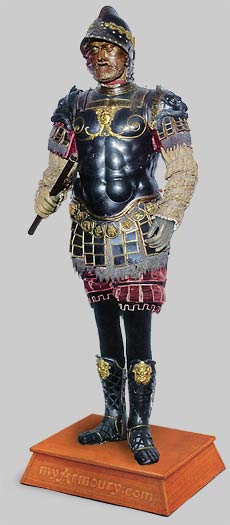 Parade Harness "Alia Romana" of the Emperor Charles V
Parade Harness "Alia Romana" of the Emperor Charles V(1500-58; Emperor, 1519) Bartolomeo Campi, Pesaro, 1546 Real Armerķa, Madrid By far the favorite armour workshop of Charles V was in Augsburg and belonged to Kolman Helmschmid and his son Desiderius. Since his victory at Pavia in 1525 the Emperor had obviously suppressed the arms production of Milan which had served the French King Francis I, taken prisoner on that occasion. It appears that in 1533 the Milanese genius Filippo Negroli was allowed to deliver a splendid example of his craftsmanship to the Emperor. From then on, northern Italy could again be counted among the suppliers to the imperial armoury, but it was not merely a question of fulfilling orders. The minor Italian princes, Gonzaga of Mantua and Montefeltro of Urbino, knew how to curry the Emperor's favor by presenting him with gifts. Guidobaldo II, Duke of Urbino, sent him an unsurpassed masterpiece bearing his initials, the mark of his goldsmith and armourer Bartolomeo Campi, the date 1546, the place of origin, Pesaro—the small Upper Italian capital on the Adriatic—and an inscription to the effect that at the urgent instigation of the Duke the work had been completed within two months, a task that would normally have taken at least a full year. Here is an unequivocal answer to the frequently asked question—how long was needed to produce such an opulent parade armour when the work was done by an eminent master with outstanding skill in every branch of his craft? Charles V appeared in this armour as the triumphant Augustus. (After all, he did consider himself the legitimate successor of the Roman emperors.) The precise reproduction of antique costume accorded perfectly with the essence of the Italian renaissance and cannot be explained away simply as a theatrical masquerade. In this instance external appearances correspond to a profound human aspiration towards an ideal. Dressed in this way, the traditions of ancient Roman pageantry were continued by the Italian princes in their trionfi and by the northerners in their entrees solennelles or joyeuses. No less a person than Michelangelo clad the figures in his Medici chapel in Florence in armour of this kind. It is based on the ancient Grecian "muscled" cuirass of bronze, a material that is still being used here to a certain extent. The boots with their embossed toes translate into steel the plaited leather of the Roman military boot. The decoration of mounted masks and scales is antique. The combination of mail and lions' masks on the pauldrons and the shape of the burgonet with its wreath of oak leaves constitute the modern elements, as does the damascening in gold and silver. About the Author Nathan Robinson has been interested in history and the hobby of reproduction arms and armour collecting for well over a decade. A professional Web developer in San Francisco, he started myArmoury.com as a resource for like-minded people and hopes to help educate and entertain enthusiasts and consumers alike. He strives to push the sword community forward, helping create a healthy market with functional and historically-researched pieces available for us all. Acknowledgements Photographs copyrighted by The Metropolitan Museum of Art, New York; The Wallace Collection, London; and Real Armerķa (Royal Armoury), Madrid |
|